New perk! Get after it with local recommendations just for you. Discover nearby events, routes out your door, and hidden gems when you sign up for the Local Running Drop.
It wasn’t long ago that triathletes believed lower and more aggressive bike positions were faster, even at the iron-distance: Slam your stem, narrow your bars, and tuck your head in between your shoulders for the fastest bike split ever.
But in 2023, we now know (hopefully) that lower and more aggressive bike positions are not necessarily faster. In fact, there is not one bike position that is faster than another. The relationship between bike position and speed is entirely individual, and that’s why the world’s best triathletes head to the wind tunnel or velodrome in search of free speed.
In this article, we’ll break down six different bike positions from the fastest triathletes in the world. Some of their positions are very similar, while others are completely different. (Jan Frodeno, for one, has a wildly different hand position from everyone else. Is that part of what makes him faster?)
While we have no interest in “critiquing” a pro triathlete’s position in this piece—particularly based on nothing more than a side-angle photo and without knowing his or her specific biomechanical particularities—rather we want to educate the reader on why a pro, who does this for a living, might choose a unique position. To help, we’ve created a glossary of common terms to learn as you go. From there, hopefully readers will understand a little bit more about bike fits and become more educated when it’s time for them to get their own.
Let’s dig in.
Section dividerPro Bike Position: Lionel Sanders
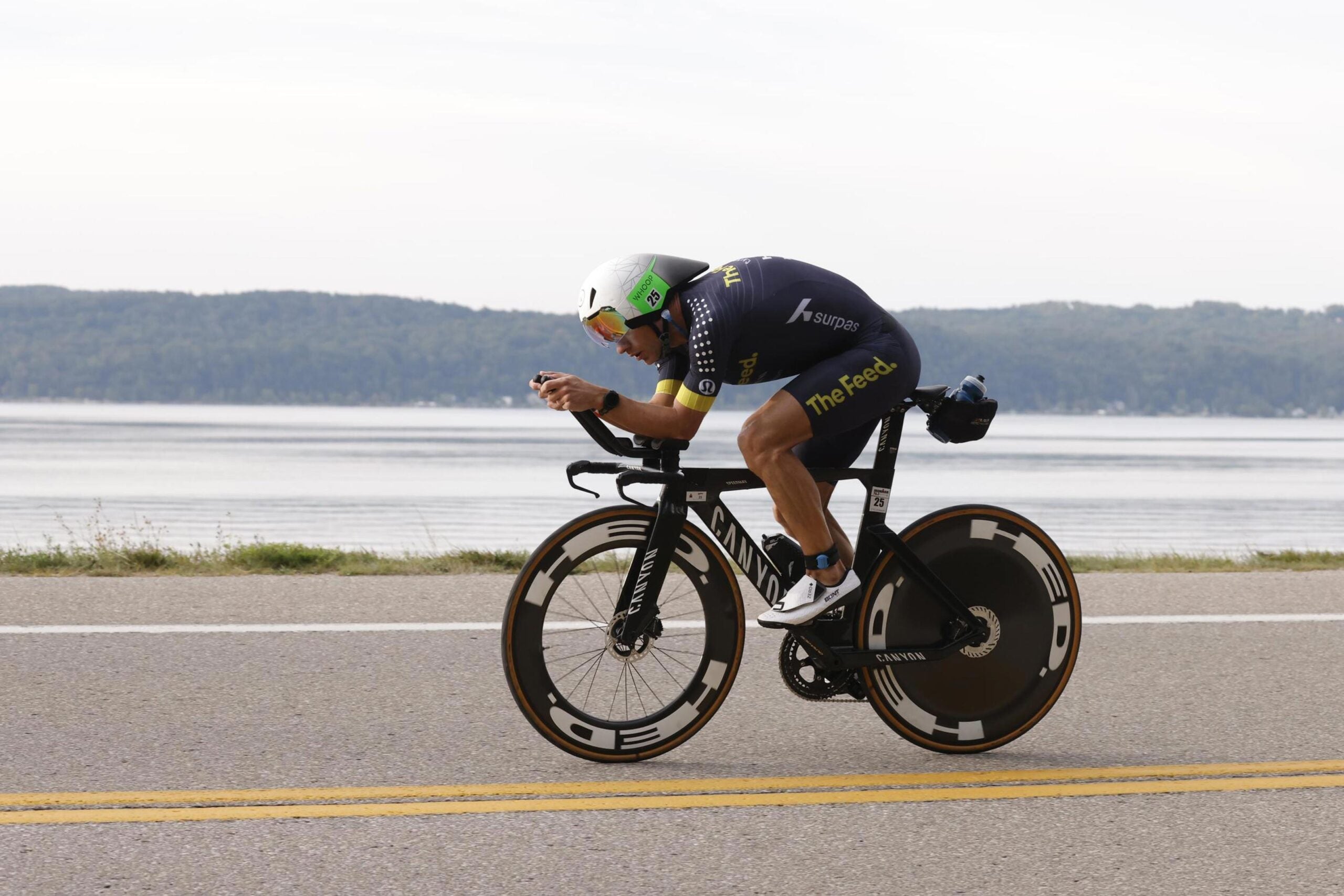
Lionel Sanders has one of the more aggressive bike positions in triathlon. Known for his insane power output and fascinating training philosophies, Sanders has been tweaking his position for years, and it shows.
Few triathletes are able to produce as much power as Sanders on the bike. But despite that, Sanders still has a lower and more aggressive position than most of his rivals. Take particular note of his hands and the position of his head.
Sanders uses high-angled bars to bring his hands up closer to his head—as opposed to flat-profile bars. This creates a smaller pocket of air between his face and his hands, which is aerodynamically faster for most athletes. However, we’ll see from the other pros that just because something is “more aerodynamic” doesn’t always mean that it’s faster for them.
- High-angled handlebars – Aero bars that tilt or angle up toward the rider’s head. This can also be called the “hands up” position.
- Flat-profile handlebars – The “traditional” handlebar position in which the aero bars are almost parallel to the ground. This can also be called the “hands down” position.
Most triathletes are unable to maintain a position as aggressive as Sanders’, especially in a long-course triathlon. Not only can Sanders maintain this position, but he can also maintain more power (330–350 W) for 2–4 hours at a time than most anyone.
Section dividerPro Bike Position: Kristian Blummenfelt
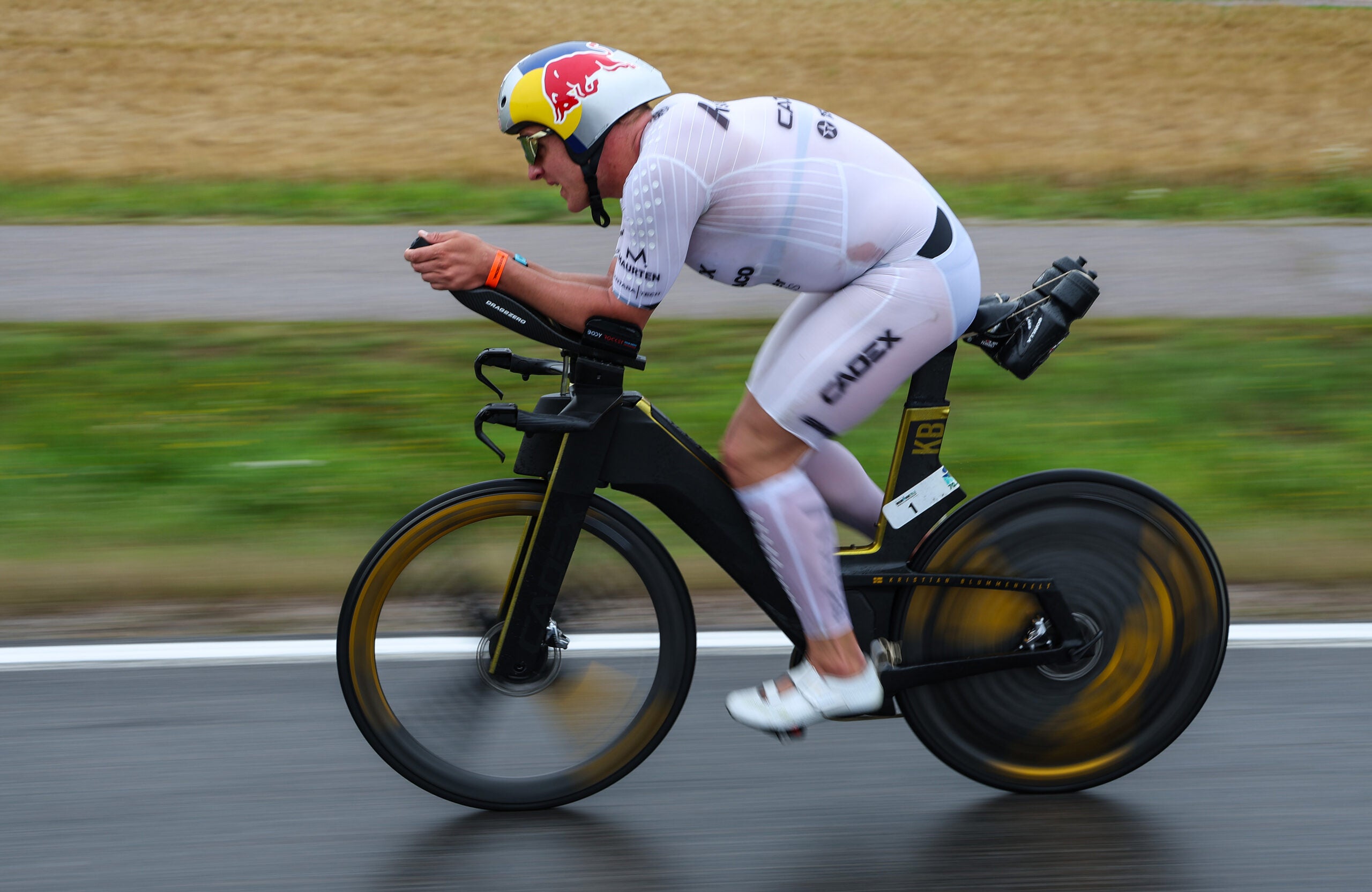
Needing no introduction, Kristian Blummenfelt has one of the most unique bike positions in professional triathlon. Depending on your perspective, you could simultaneously say that Blummenfelt’s position is aggressive and relaxed – and you’d be correct with both assessments.
Blummenfelt’s aero bars aren’t just angled up, they are tilted up from the base of the bar—unlike Sanders, above. This could place more stress on Blummenfelt’s elbows rather than his forearms, but it clearly is a comfortable position for him.
At the top of the pedalstroke, Blummenfelt has quite a tight hip angle, which is bothersome for most athletes. But the Norwegian seems to have quite flexible and powerful hip flexors, which means that he can create lots of power from this slightly cramped position. The rider we’ll look at next has many opposite features in their bike position.
- Hip angle – The angle between the rider’s trunk and thigh
Author’s note: As someone who loves power data, I admire Blummenfelt’s commitment to keeping his bike computer three inches away from his face.
Take a closer look at this photo of Sanders and Blummenfelt riding side-by-side. Now you can really see the differences – Blummenfelt is much higher up, but also more compact. Sanders’ position is low and aggressive, much lower than Blummenfelt’s. But in most races, these competitors are nearly equal on the bike. Maybe one day we will have Blummenfelt’s power data to see how many more (or fewer) watts he uses than Sanders.
Section divider
View this post on Instagram
Pro Bike Position: Jan Frodeno

In stark contrast to both Blummenfelt and Sanders, Jan Frodeno uses flat handlebars instead of high-angled ones. His forearms run parallel to the ground, which may place more pressure on his wrists and hands than his elbows.
There is a larger pocket of air between Frodeno’s head and his hands, but this is what works best for him, individually. Flat handlebars may allow the athlete to open up their chest more, which can improve breathing, depending on the rider’s physiology.
In fact, Frodeno’s aero bars are fully custom – the Jan Frodeno Mono-Cockpit. It’s safe to say that he has spent hours testing out different styles and shapes of aero bars.
One of the tallest triathletes around, Frodeno has a larger bike frame and more saddle height than most of his competitors (you can see more details on his bike here). His bike position is relatively stretched out compared to Sanders’ and Blummenfelt’s, which leaves plenty of room to extend his legs all the way through the pedaling motion.
You can also see that Frodeno has a flat back, especially compared to Blummenfelt. This keeps his spine in alignment with his core, but this is not a universal positive for triathletes. As we can see from Blummenfelt’s position, there are plenty of triathletes who prefer a rounded back position, staying tucked in like a turtle rather than spread out and extended.
- Flat back: A bike position in which the rider’s spine is roughly parallel to the ground. Typically, a flat back helps open up the rider’s hip angle and stabilize the core.
- Rounded back: A bike position in which the rider’s lower or upper back is rounded. Typically a rounded back position helps the rider punch a smaller and more aerodynamic hole in the wind, though it can be uncomfortable to hold this position for a long period of time.
Pro Bike Position: Taylor Knibb
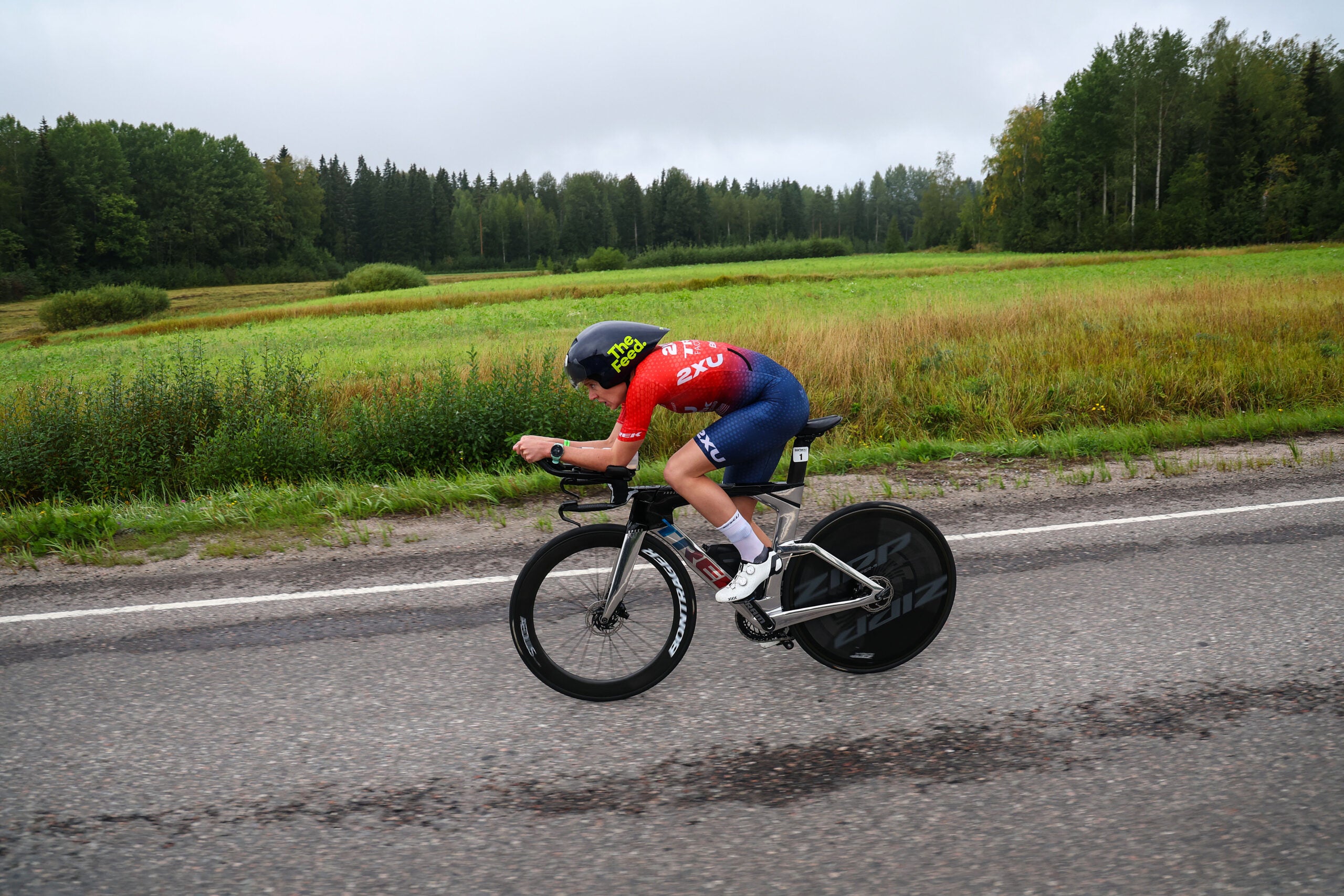
Taylor Knibb, who has added cycling time trials to her two-wheeled repertoire this year, is the perfect example of a balanced bike position and proof that there is no “secret sauce” for creating the fastest bike position. Knibb’s aero bars are a much less extreme version of Blummenfelt’s high-angled handlebars.
Slightly tilted up from the base of the bar, Knibb’s aero bars provide a solid platform for her elbows and forearms. Of all the positions we’re analyzing today, Knibb’s arms are extended the furthest out in front of her. Potentially, this could improve her aerodynamics and breathing, but it could also compromise her bike handling ability. Thankfully, you typically don’t have to steer much in the aero bars.
Knibb sits far forward on the saddle, just like most other triathletes, and she has an open hip angle. Her back isn’t perfectly flat, but it isn’t very rounded either. Overall, Knibb’s bike position proves that you don’t need to go to extremes to be one of the fastest triathletes in the world.
Section dividerPro Bike Position: Lucy Charles-Barclay
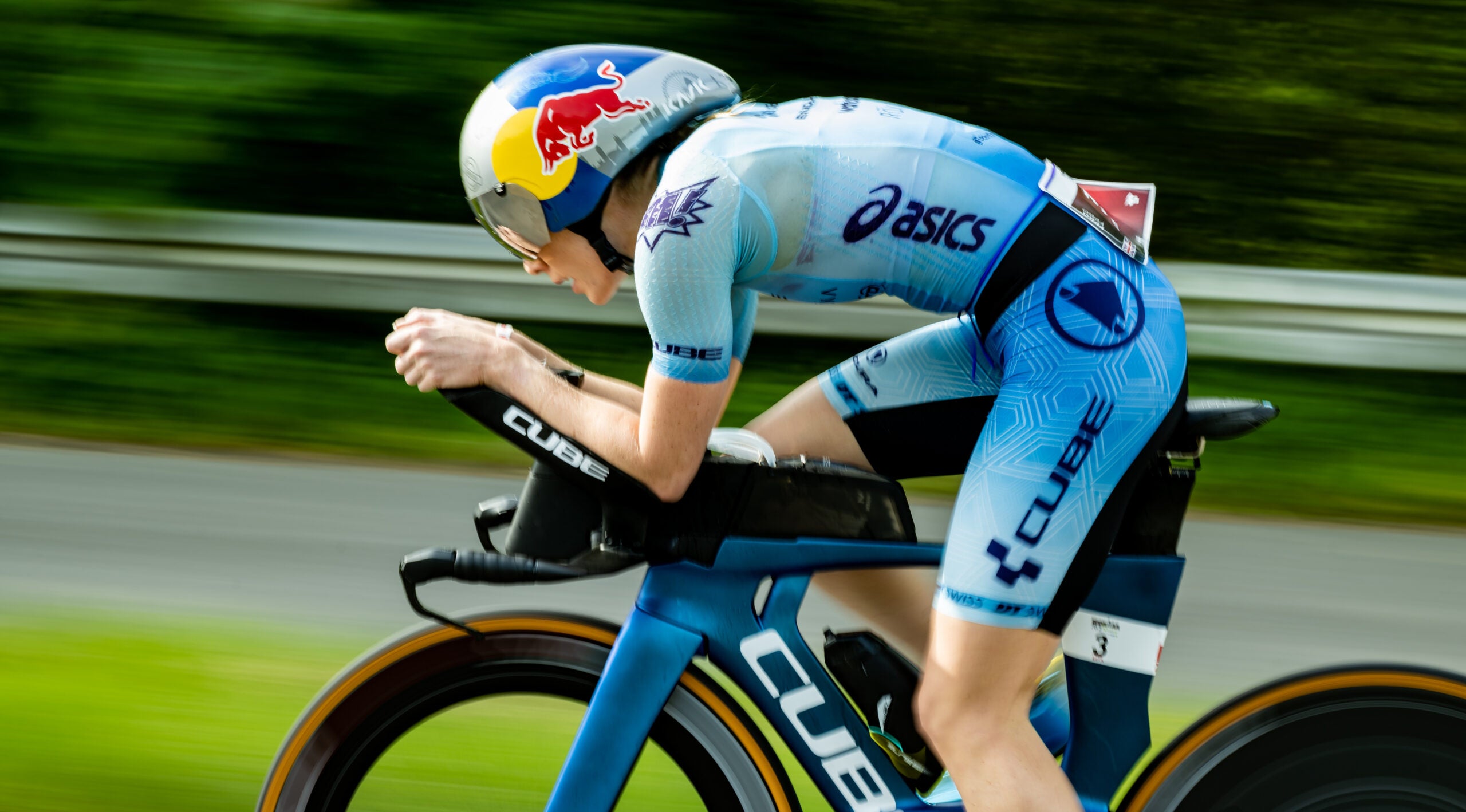
The one thing that really stands out from Lucy Charles-Barclay’s bike position is her head position. Unlike most triathletes, Charles-Barclay keeps her head low and angled down – this head position is much more common in road cycling time trials when the distances are shorter and speeds are higher.
A low and more tucked-in head position is a risk that many professional athletes are willing to take. It puts quite a strain on your neck in order to see the road in front of you, but the results from the wind tunnel prove that a lower head position is almost always faster.
Like Blummenfelt, Charles-Barclay uses aero bars that are tilted up from the bottom of the bars to the top. This closes the gap between her hands and her head, allowing wind to funnel over her rather than hitting her in the chest.
Section dividerPro Bike Position: Ashleigh Gentle
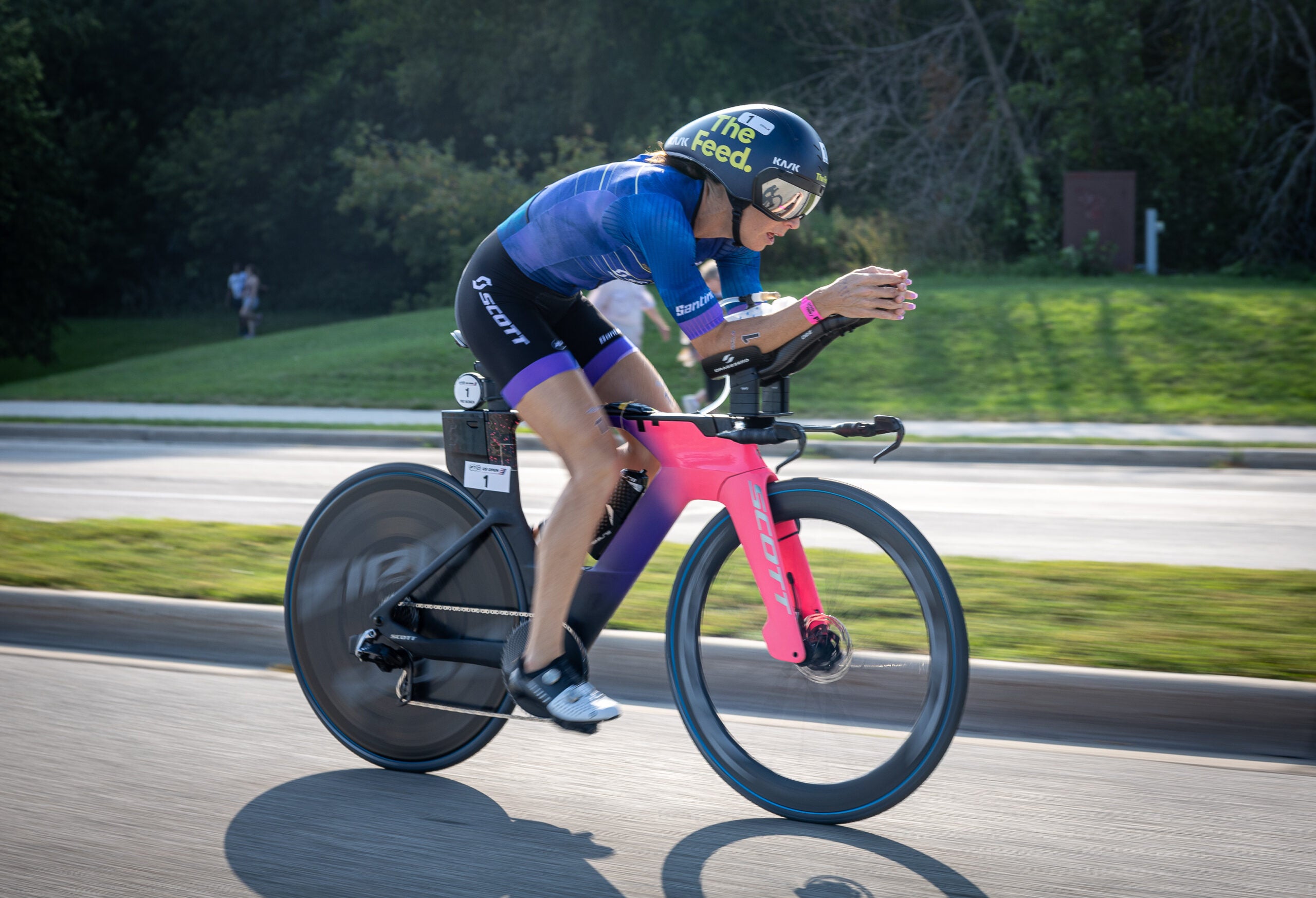
Ashleigh Gentle’s bike position is really interesting because it doesn’t actually look that fast. If you asked any amateur to critique her position, they would probably say that her bars are too high, and her back is anything but flat.
But in reality, Gentle is one of the fastest cyclists in the world, and she is currently number-one in the PTO World Rankings. She knows exactly what she’s doing.
Indeed, Gentle’s aero bars are not just tilted skyward, but they are also raised up from the base bar. Just look at those risers – her elbows are at least four inches above her TT frame. Gentle also has a unique back position. It is not only flat or rounded, but it is actually angled slightly upwards. That means that her shoulders are significantly higher than her hips. If you take a look at the other positions above, you’ll see that no one else’s shoulders are that high above their hips.
Part of the reason that Gentle’s chest is tilted up is that she has to be able to see over her hands. If she had a flat back, her line of sight would run straight into her knuckles. Clearly, Gentle has tested and perfected this position over many years, but it is fascinating to see specific features stand out among the world’s best triathletes.
Pro Bike Position: Conclusions
Each triathlete here has their own unique position: Frodeno has flat aero bars, Blummenfelt has a rounded back, and Charles-Barclay tries to keep her head down at 28mph.
When it comes to aero-testing your own bike position, it’s important to remember that one size does not fit all. There is not a declared winner in the battle between flat vs. rounded backs or high-angled vs. flat handlebars. Extreme positions don’t always increase your speed, especially when you have to put out power for hours at a time. For the best results, work with a qualified bike fitter to find the best setup for you.
As Lucy Charles-Barclay said while testing equipment in the wind tunnel: In the sport of long-course triathlon, the goal is to be “as aerodynamic as possible and as comfortable as possible.”